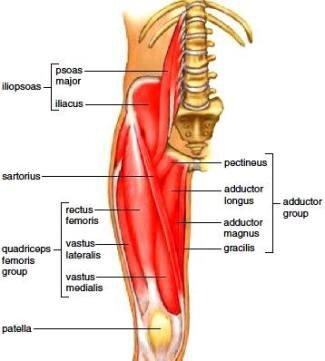Tight Hip Flexors?
Are your hip flexors actually tight, or do you just perceive them as being tight? Believe it or not these can be 2 different things. Due to many of us sitting for a good part of the day , weakness directly in the flexor group and/or glute complex, and the high prevalence of low back pain, many of us have legit hip flexor mobility deficits. If you pass the following tests but still perceive them as being tight, its probably a strengthening issue and you should concentrate your efforts on such.
Your hip flexors are actually a group of muscles that, surprise, flex your hips. They are mainly comprised of your Iliacus, Psoas (major and minor), and Rectus Femoris. The Iliacus and Psoas are very closely related and often called the ‘Iliopsoas.’ Tight hip flexors limit the mobility of your hip, which is designed to be a super mobile joint. Your hip is connected to your lower back, which is supposed to be a super stable area. Lack of mobility in the hip translates to extra forces spanning the hip and low back. With the direct connection of the Iliopsoas to the lumbar spine, it is no wonder that people with tight hip flexors very often have low back or SI joint pain.
In these videos you'll see a commonly used test in the rehab industry called the Thomas Test to objectively assess hip flexor mobility.
Video# 1 If your femur is NOT parallel to the table or floor, this means your Iliopsoas OR Rectus Femoris IS tight.
Video #2 If your femur IS parallel to the table or floor, but your knee CANNOT bend to 90 degrees, your Rectus Femoris IS tight.
Video #3 If your femur IS parallel to the table or floor and your knee CAN bend to 90 degrees, you've passed the test. You do NOT have a tight hip flexor.
Now try the other side!
If you did not pass the test, here are a few things you can do about it:
Find your bellybutton and go down and out at a 45 degree angle to find your Iliopsoas Muscle
Find your hip bone and go down and just slightly in to find your Rectus Femoris muscle.
Determine which muscle needs to be released and complete the Hip Flexor Self Myofascial Release:
Directions:
Lying on your back, find the muscle you want to release.
Place a lacrosse ball, baseball, softball, or golf ball on the muscle and put a kettlebell on top. In this video I’m using a 20# KB, but can offload the weight with my arms as much as needed. Make it hurt so good!
Start off with a series of long diaphragmatic exhales to allow the ball to sink into the musculature.
Slowly bring your heel to your butt and back out.
Do this for a few minutes and then retest your Thomas Test.
Once you can pass the test, follow up with a variation of the Psoas March:
Retest the original Thomas Test to see what progress you made.
If you’re stuck and need help getting pain free, we’d love to chat. Schedule a free consultation HERE to see how we can help.
Dr. Dave



